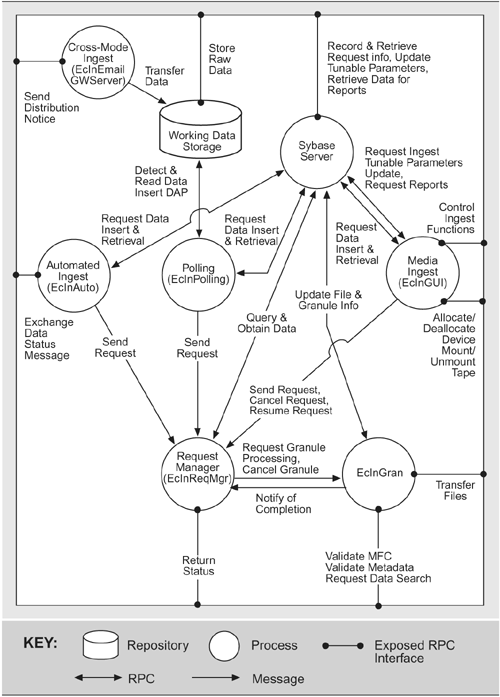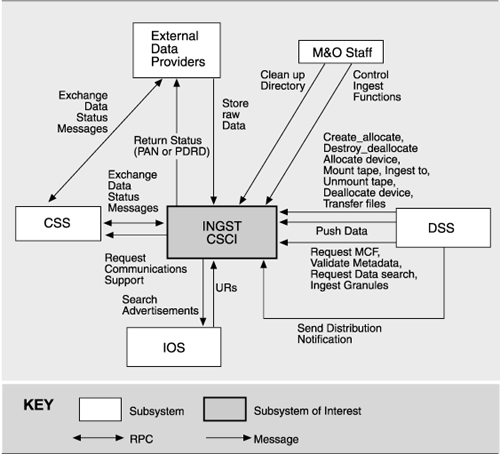C&C Communicating-Processes View
C C Communicating Processes View
7.1 C&C Communicating-Processes View Packet 1: Ingest Subsystem
The Ingest subsystem deals with the initial reception of all data received at an EOSDIS facility and triggers subsequent archiving and processing of the data. It makes data ingest schedules available for access by users and programs and reports deviations from the schedules as exceptions so they can be handled through intervention by operations or science users.
7.1.1 Primary Presentation

7.1.2 Element Catalog
7.1.2.1 Elements and Their Properties
Properties of Ingest subsystem communicating-processes components and connectors, given in the following table, are
- Name
- Type
- Description
| Element Name | Type | Description |
|---|---|---|
| EcInAuto | Process | Auto Ingest: Provides fundamental capabilities for data ingest into the SDPS, on receipt of a data availability notice (DAN). This process can be tailored for a specific interface. RPCs are used to request ingest services to schedule data transfer from the source. EcInAuto also
|
| EcInPolling | Process | Polling Ingest
|
| EcInGUI | Process | Ingest GUI: provides Maintenance and Operations (M&O) personnel with the capability, via GUI Interface, to
|
| EcInReqMgr | Process |
Request Manager
In the event of a failure, the EcInReqMgr process restores ongoing requests from the Ingest database. |
| EcIn Email GWServer | Process | Ingest E-mail Gateway Server
|
| EcInGran | Process |
Granule Server provides services to perform the required data preprocessing and the subsequent data insertion into the appropriate Data Server. The preprocessing of data consists of
EcInGran coordinates the ingest granule processing, including
|
| Sybase Server | Process | Stores and provides access to the INS internal data. In particular, the database stores the Ingest operations databases: Ingest History Logs and the Ingest request checkpoint state and template information. |
| RPC | Synch call | Exchanges data status, detects and reads data, sends updates, deletions, and other instructions. |
| Notification | Event | Notifies of activity completion and data distribution. The two approaches to initiating event communication are called the push model and the pull model. The push model allows a supplier of events to initiate the transfer of the event data to consumers. The pull model allows a consumer of events to request the event data from a supplier. In the push model, the supplier is taking the initiative. |
| SQL | DB Query/Resp | Database query/response mechanism. |
| [etc.] | [etc.] | [etc.] |
7.1.2.2 Relations and Their Properties
Attachment, showing how the components and connectors are attached to each other. The primary presentation shows all attachments.
7.1.2.3 Interfaces
Interfaces for the elements shown in this view are specified under the corresponding element in the module decomposition view (Volume II, Chapter 1). To identify those elements, consult Volume I, Chapter 4.
7.1.2.4 Element Behavior
[omitted]
7.1.3 Context Diagram

7.1.4 Variability Guide
None.
7.1.5 Architecture Background
7.1.5.1 Design Rationale
- The subsystem supports the ingest of data into ECS repositories on a routine and ad hoc basis. Given the variety of possible data formats and structures, each external interface and each ad hoc ingest task may have unique aspects. Therefore, the Ingest subsystem is organized into a collection of software componentsingest management software, translation tools, media-handling softwarefrom which those required in a specific situation can be readily configured. The resultant configuration is called an ingest client, which can either operate on a continuous basis to serve a routine external interface or exist only for the duration of a specific ad hoc ingest task.
- Ingest subsystem software services are designed to support fault tolerance, graceful degradation, and effective recovery, such as automatic switchover to backup resources when primary resources fail; flexibility to handle various types of quality assurance for products, on-site as well as off-site; and retaining production history to allow reprocessing in case of data loss.
[etc.]
7.1.5.2 Results of Analysis
None.
7.1.5.3 Assumptions
- A DAAC will often preprocess ingested ancillary data, correlative data, documents, and so on into another format for the purposes of processing. This will result in data represented in both the original native format and the preprocessed format.
- Only preprocessed data will be archived unless there is no means by which the native data could be reacquired.
[etc.]
7.1.6 Other Information
[omitted]
7.1.7 Related View Packets
- Parent: None in this view. View packets in other views showing the Science Data Processing Segment (SDPS) are beyond views parents.
- Children: None
- Siblings
- C&C Communicating-Processes View Packet 2: Data Server Subsystem (Volume II, Section 7.2, page 456)
- C&C Communicating-Processes View Packet 3: Data Management Subsystem (Volume II, Section 7.3, page 456)
- C&C Communicating-Processes View Packet 4: Client Subsystem (Volume II, Section 7.4, page 456)
- C&C Communicating-Processes View Packet 5: Interoperability Subsystem (Volume II, Section 7.5, page 456)
- C&C Communicating-Processes View Packet 6: Planning Subsystem (Volume II, Section 7.6, page 456)
- C&C Communicating-Processes View Packet 7: Data Processing Subsystem (Volume II, Section 7.7, page 456)
- C&C Communicating-Processes View Packet 8: Communications Subsystem (Volume II, Section 7.8, page 456)
- C&C Communicating-Processes View Packet 9: System Management Subsystem (Volume II, Section 7.9, page 456)
- C&C Communicating-Processes View Packet 10: Internetworking Subsystem (Volume II, Section 7.10, page 456)
7.2 C&C Communicating-Processes View Packet 2: Data Server Subsystem
[omitted]
7.3 C&C Communicating-Processes View Packet 3: Data Management Subsystem
[omitted]
7.4 C&C Communicating-Processes View Packet 4: Client Subsystem
[omitted]
7.5 C&C Communicating-Processes View Packet 5: Interoperability Subsystem
[omitted]
7.6 C&C Communicating-Processes View Packet 6: Planning Subsystem
[omitted]
7.7 C&C Communicating-Processes View Packet 7: Data Processing Subsystem
[omitted]
7.8 C&C Communicating-Processes View Packet 8: Communications Subsystem
[omitted]
7.9 C&C Communicating-Processes View Packet 9: System Management Subsystem
[omitted]
7.10 C&C Communicating-Processes View Packet 10: Internetworking Subsystem
[omitted]
Software Architectures and Documentation
- P.1. The Role of Architecture
- P.2. Uses of Architecture Documentation
- P.3. Interfaces
- P.4. Views
- P.5. Viewtypes and Styles
- P.6. Seven Rules for Sound Documentation
- P.7. Summary Checklist
- P.8. Discussion Questions
- P.9. For Further Reading
Part I. Software Architecture Viewtypes and Styles
The Module Viewtype
- Overview
- Elements, Relations, and Properties of the Module Viewtype
- What the Module Viewtype Is For and What Its Not For
- Notations for the Module Viewtype
- Relation to Other Viewtypes
- Summary Checklist
- Discussion Questions
- For Further Reading
Styles of the Module Viewtype
- Styles of the Module Viewtype
- Decomposition Style
- Uses Style
- Generalization Style
- Layered Style
- Summary Checklist
- Discussion Questions
- For Further Reading
The Component-and-Connector Viewtype
- Overview
- Elements, Relations, and Properties of the C&C Viewtype
- What the C&C Viewtype Is For and What Its Not For
- Relation to Other Viewtypes
- Summary Checklist
- Discussion Questions
- For Further Reading
Styles of the Component-and-Connector Viewtype
- Styles of the Component-and-Connector Viewtype
- The Pipe-and-Filter Style
- Shared-Data Style
- Publish-Subscribe Style
- Client-Server Style
- Peer-to-Peer Style
- Communicating-Processes Style
- Notations for C&C Styles
- Summary Checklist
- Discussion Questions
- For Further Reading
The Allocation Viewtype and Styles
- Overview
- Elements, Relations, and Properties of the Allocation Viewtype
- Deployment Style
- Implementation Style
- Work Assignment Style
- Summary Checklist
- Discussion Questions
- For Further Reading
Part II. Software Architecture Documentation in Practice
- Part II. Software Architecture Documentation in Practice
- ECS Architecture Documentation Roadmap
- ECS System Overview
- ECS Software Architecture View Template
- Mapping Between Views
- Directory
- Architecture Glossary and Acronym List
- Module Decomposition View
- Module Uses View
- Module Generalization View
- Module Layered View
- C&C Pipe-and-Filter View
- C&C Shared-Data View
- C&C Communicating-Processes View
- Allocation Deployment View
- Allocation Implementation View
- Allocation Work Assignment View
Advanced Concepts
- Advanced Concepts
- Chunking Information: View Packets, Refinement, and Descriptive Completeness
- Using Context Diagrams
- Combined Views
- Documenting Variability and Dynamism
- Creating and Documenting a New Style
- Summary Checklist
- Discussion Questions
- For Further Reading
Documenting Software Interfaces
- Overview
- Interface Specifications
- A Standard Organization for Interface Documentation
- Stakeholders of Interface Documentation
- Notation for Interface Documentation
- Examples of Interface Documentation
- Summary Checklist
- Discussion Questions
- For Further Reading
Documenting Behavior
- Beyond Structure
- Where to Document Behavior
- Why to Document Behavior
- What to Document
- How to Document Behavior: Notations and Languages
- Summary Checklist
- Discussion Questions
- For Further Reading
Choosing the Views
- Choosing the Views
- Stakeholders and Their Documentation Needs
- Making the Choice
- Two Examples
- Summary Checklist
- Discussion Questions
- For Further Reading
Building the Documentation Package
- Building the Documentation Package
- One Document or Several?
- Documenting a View
- Documentation Beyond Views
- Validating Software Architecture Documentation
- Summary Checklist
- Discussion Questions
- For Further Reading
Other Views and Beyond
- Other Views and Beyond
- Overview
- Rational Unified Process/Kruchten 4+1
- UML
- Siemens Four Views
- C4ISR Architecture Framework
- ANSI/IEEE-1471-2000
- Data Flow and Control Flow
- RM-ODP
- Where Architecture Documentation Ends
- A Final Word
- For Further Reading
- Appendix A. Excerpts from a Software Architecture Documentation Package
- Volume I ECS Software Architecture Documentation Beyond Views
Rationale, Background, and Design Constraints
References
EAN: 2147483647
Pages: 152
